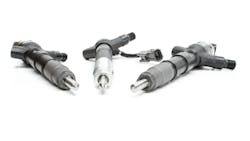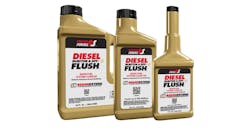How fuel system flushes improve engine reliability
The modern fleet manager operates in a world where diesel fuel quality is extremely inconsistent and High Pressure Commons Rail (HPCR) engines are increasingly sensitive to the smallest traces of contaminants. Diesel fuel chemistry varies greatly when sourced from different terminals, regions, and from season to season. Trace amounts of contaminants can enter the fuel system during transportation and storage. This variability is compounded by the increasing use of biodiesel (BXX) and renewable diesel (RD), which introduce new chemical properties and variables that can heighten the risk of deposit formation, poor fuel economy, and DPF clogging. These inconsistencies are a primary challenge to fleet reliability, as managers often have little control over the quality of fuel that enters their tanks.
A proactive and easy-to-use solution, like a comprehensive fuel system flush, is the only tool that allows fleet managers to take back control and ensure fuel system integrity, regardless of the quality of the diesel received. To achieve this necessary control over operational efficiency, Power Service has introduced Diesel Injector & DPF Flush, a new, comprehensive solution designed to be a core part of your preventive maintenance routine.
The chemistry of clogging: Why injectors fail
Injector issues boil down to two main types of deposits, both fueled by the inherent chemistry of diesel, its aging process, and contamination:
1. Internal diesel injector deposits (IDIDs)
These occur inside the injector body, typically on the critical moving parts like the control valve. They often are formed by contaminants such as trace amounts of minerals like sodium, calcium, zinc, or fatty acid methyl esters (FAME) that get past filtration. In the extreme heat and pressure of the HPCR system (often exceeding 30,000 psi), these trace elements polymerize and form deposits.
IDIDs physically impede the motion of internal components. They can cause injectors to stick open or closed. This leads to slow injection response times, rough idling, lost power, inconsistent fuel metering, and a loss of precise timing — all of which compromise the engine's ability to operate efficiently and can lead to premature wear and tear.
2. External injector tip deposits (nozzle coking)
These are visible deposits that build up on the nozzle and tip of the injector, where the fuel meets the combustion chamber. These are composed primarily of asphaltenes, paraffins, and un-combusted hydrocarbons. As the injector tip operates, residual unburned fuel on the hot surface "cokes" or hardens into varnish-like deposits.
Nozzle coking physically alters the shape of the fuel spray. Instead of a precisely atomized, fine cone, the spray pattern becomes distorted — leading to fuel droplets that are too large and unevenly distributed in the cylinder, causing incomplete combustion and excessive exhaust.
The cascading failure: From poor combustion to DPF overload
The primary function of the injector is to ensure complete combustion. When deposits distort the spray pattern, that primary function fails, initiating a costly domino effect that leads directly to DPF issues.
1st incomplete combustion: When fuel droplets are too large due to a fouled nozzle, they cannot vaporize and mix with air effectively before the combustion event ends. This results in incomplete combustion and an immediate spike in the production of particulate matter or soot.
2nd DPF overloading: The DPF is designed to capture this soot. However, if the engine is producing 10%, 20%, or even 30% more soot than normal due to poor injection, the DPF reaches its capacity threshold much faster.
3rd regeneration frequency spike: This decrease in the miles between regenerations is where your costs can soar:
- Fuel consumption: Active regeneration involves injecting fuel post-combustion to raise the exhaust temperature to over 1100 degrees F to burn off the trapped soot. Increased frequency equals increased fuel consumption.
- Downtime: Frequent regeneration means the vehicle either is tied up sitting idle to complete the cycle or, worse, requires a manual, forced regeneration, leading to operational downtime.
4th fuel economy deterioration: Beyond the DPF-related costs, injector contamination and subsequent incomplete combustion directly sabotage fuel economy (MPG). Deposits, whether internal or external, compromise the efficiency and precise timing of the fuel delivery. When the fuel spray is distorted, a significant portion of the diesel fails to convert into useful kinetic energy, effectively wasting fuel. Furthermore, the Engine Control Module (ECM), detecting the compromised combustion quality, may attempt to compensate by advancing timing or increasing the quantity of fuel injected to meet performance demands, creating an immediate and continuous drop in the fleet's average fuel economy.
The solution: Power Service Diesel Injector & DPF Flush
This product is a rapid-acting, highly concentrated detergent formulated with proprietary technologies to attack deposits throughout the entire fuel and emissions pathway. In a single tank treatment, it delivers tested and verifiable performance gains:
- Simplicity and zero downtime: Diesel Injector & DPF Flush is a simple pour-in solution that requires no special tools, technician labor, or vehicle downtime. It can easily be administered by any driver or fleet technician, making application a non-issue in the maintenance schedule.
- Injector restoration & power recovery: The high concentration of powerful detergents quickly removes external nozzle coking and stubborn IDIDs. Industry standard DW-10B testing showed the formula restored 6% power loss (often surpassing the baseline) within one hour of run time.
- RegenExtend technology for DPF management: This exclusive chemistry reduces the frequency and duration of DPF regenerations by up to 50%, resulting in maximum time spent in service and minimal fuel spent on regens.
- Fuel economy improvement: By restoring injector spray patterns, fuel economy can be improved up to 10% (with observed heavy-duty results up to 40%) and a sustained reduction in fuel consumption per mile.
- Full system clean-up: Works through the entire exhaust aftertreatment system, including the turbo and EGR, preventing upstream components from immediately re-contaminating the DPF.
- NOx reduction: Reduces NOx emissions by up to 50%, minimizing stress and wear on the Selective Catalytic Reduction (SCR) system.
Shifting to proactive DPF health
The data speaks for itself: In recent field trials using this product, vehicles saw a dramatic increase in miles driven between regenerations, in some cases nearing 100%, after just a single tank treatment.
For the fleet manager, this product is more than a cleanup tool; it’s a strategy shift. By integrating Power Service Diesel Injector & DPF Flush into your monthly maintenance schedule, you shift from reactive maintenance (addressing a flashing check-engine light or a forced regen code) to a proactive system that:
- Maximizes engine efficiency and mpg
- Minimizes active regeneration frequency and associated fuel costs
- Extends the life of your expensive DPF and injection components
In the challenging environment of modern diesel fleet operation, maximizing uptime starts at a molecular level with clean fuel and a clean burn. Diesel Injector & DPF Flush is the most direct way to ensure both.
About the Author

Jessica Crabtree
Director of Technical Services
Jessica Crabtree is the director of Technical Services at Power Service, where she leads the company’s laboratory operations spanning research and development, quality control, and customer fuel sampling. Since joining straight out of college nearly 11 years ago, she has become a go-to expert in diesel fuel chemistry and additive formulation, directly managing all product formulations and overseeing continuous efficacy testing on more than 2,000 unique fuel samples each year. Jessica maintains Power Service’s specialized testing equipment, ensures timely processing of customer samples, and manages EPA fuel additive registrations. She also authors technical website content, bulletins, and white papers that translate complex fuel science into practical guidance for customers.
A graduate of Midwestern State University with a B.S. in Chemistry and a minor in Mathematics, Jessica stays current with industry standards and trends through participation in organizations and events such as ASTM, SAE, the National Biodiesel Board, and, most recently, the Petroleum Packaging Council. Her work helps ensure Power Service delivers the most effective additives across the widest range of diesel fuels.

